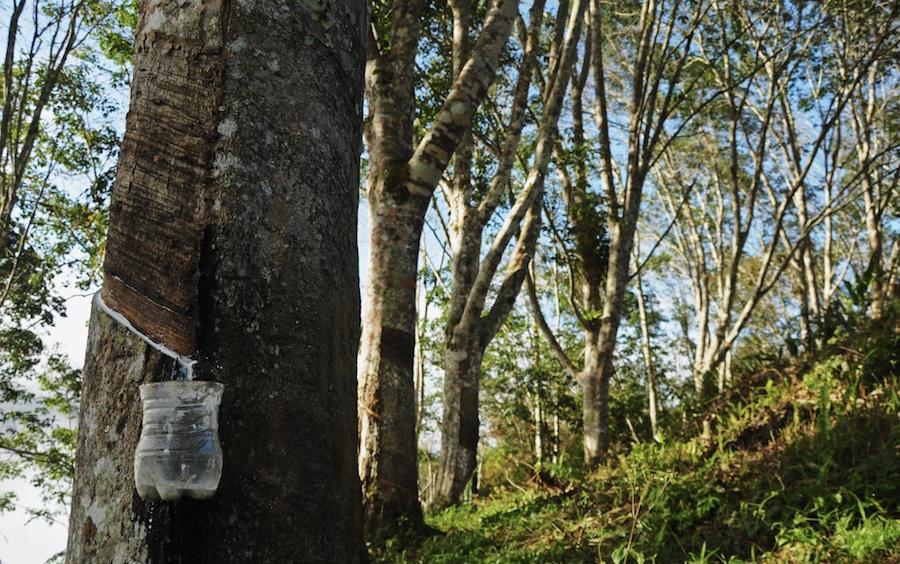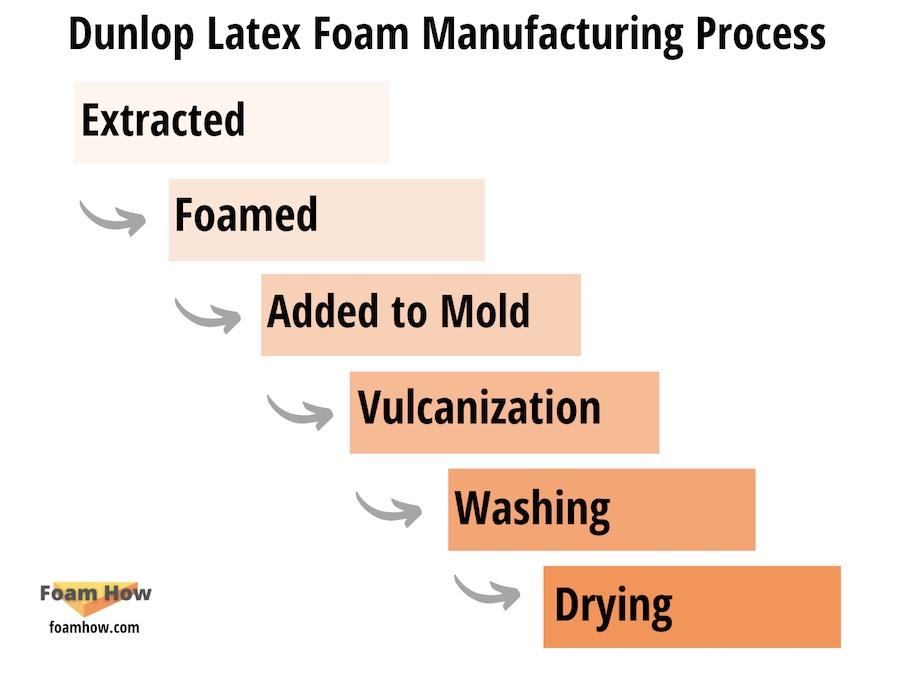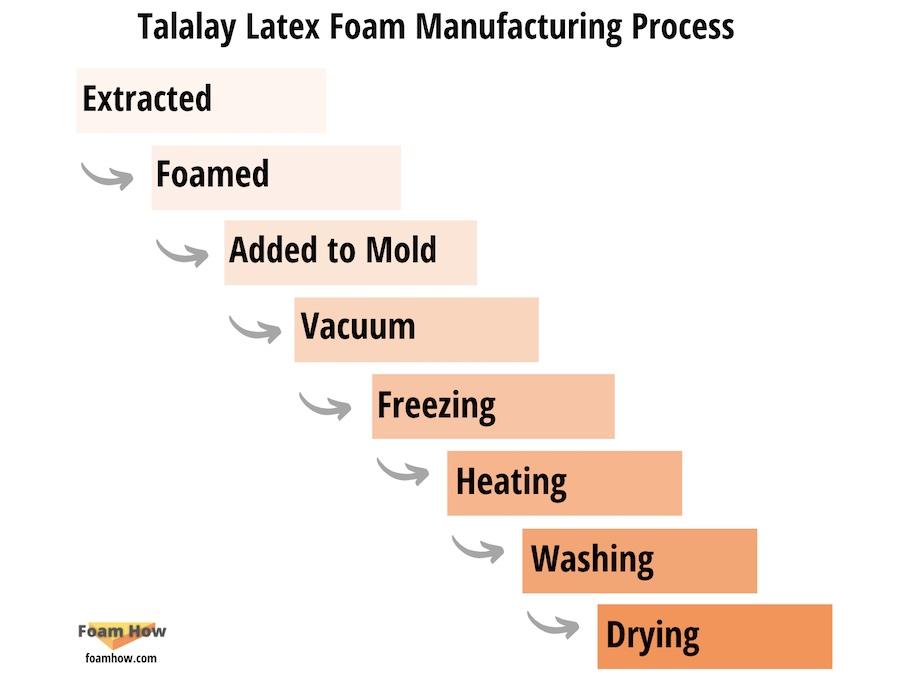Here’s where I go through what Latex is made of as we progress through the process of making the various forms of latex. Let’s start with a quick summary.
Generally, latex is derived from the white, milky fluid beneath the bark of the rubber tree. Rubber is made from latex, at around 55% water and 40% rubber. Raw fluid is sent through a Dunlop or Talalay method of processing to make latex foam. There are around 200 plant types that produce latex.
And I should add that organic latex is eco-friendly and toxic-free.
How it’s made, the process
Natural latex is produced from the “Hevea Brasiliense”; a rubber tree and is the protective, soft, white, milky fluid contained beneath the bark.
Rubber trees have tubes providing a continuous flow of latex known as “Latex vessels”.
These latex vessels grow in a spiral formation around the bark of the rubber tree. When latex needs to be harvested, the bark of the rubber tree is very carefully stripped to expose the latex vessels.
After slicing back the bark of the rubber tree, the latex vessels are exposed. The latex then naturally runs down the side of the tree. A container is placed to collect the latex that runs down the tree. Traditionally, a coconut shell was used for this purpose.
The collected latex is then taken to a processing unit where it’s put into tanks for transporting to manufacturing facilities or supplied as raw material to other product producers.
This raw form of latex has a composition that consists of 30-40% rubber particles, 55-65% water, and small amounts of protein, sterol glycosides, resins, ash, and sugars.
You can get a further overview on how Latex foam differs from other foams from my article types of foam.

The basic process of how latex is made
Latex is made for a variety of uses, for which the most popular is for foam-related products.
Depending on the particular use of the latex, the extracted raw material is put through different processing.
The following is the most popular method of production from raw latex, the processing, and how latex foam is made.
Processing latex into latex foam
Latex is processed into latex foam using two main processing methods, as follows:
Dunlop process
The Dunlop method is considered the most energy-efficient method of producing latex foam.
The liquid form of latex is foamed and poured into a mold. The mold is then closed and added to a conveyor belt, from where it’s then transported into a vulcanization oven.
Vulcanization, simply put, is a chemical process. Rubber is heated with sulphur, and added accelerator, and activator elements. At 284°F – 320°F (140–160°C) it forms cross-links between rubber molecules. Resulting in greater elasticity, and strength. Plus added resilience, viscosity, and firmness.
Once the vulcanization process is complete, the foamed latex is removed from the mold and then sent to a washing station.
In the washing station, the foam is thoroughly washed, and any residue removed. Rinsing then removes any soap and other excess materials that may be sticking to the foam.
After washing, the foam is then dried at a high temperature.
Drying helps in removing all the moisture that came with the washing process, and make the final product i.e. latex foam moisture-free.

Talalay process
This is a more energy-intensive method of processing latex foam.
This process follows many steps in line with the Dunlop process. However unlike in the Dunlop process, once the latex is foamed, it’s poured into the lower half of a mold.
Once the mold is partially filled, it’s sealed with a lid and is expanded by a high-pressure vacuum to fill the rest of the mold.
Once the mold is finally full from the vacuum expansion process, the mold is then frozen.
At this freezing point, carbon dioxide gas is pushed through the latex. This is done to make the latex more of a gel-type texture.
Then, as with the Dunlop process, the temperature is raised to a similar temperature of around 220ºF (104°C) to vulcanize the latex.
Finally similar to the Dunlop process the foam is then washed to get rid of dirt and then dried to make the final product moisture-free.

To help with this topic, refer to my article on what is Latex foam.
Common uses for latex
The dipped goods industry makes a variety of uses out of latex, which includes the production of things like:
- Medical and surgical products
- Mattresses and furniture padding
- Cosmetics
- Household and industrial gloves
- Balloons
- Swimming caps
- Rubber bands
- Chewing gum
- Boots
- Tennis shoes and sports shoes
- Paints
- Adhesives
The adhesive industry is a famous user of latex to produce envelopes, labels, shoes, and pressure-sensitive tapes. Other products include clothing, catheters, and sporting goods
The synthetic version of latex is also used in paints and glues. These synthetic latexes are also mixed with cement to resurface or patch cracks in cement surfaces.
Natural latex is made with high solid content and is used within products like:
- Cement
- Wax
- Low-temperature metals
- Casting plaster
- Some polyester articles
Especially when it comes to casting, latex can shrink around an object that needs to be reproduced to provide a mold or cast.
This gives it the ability to reproduce even the smallest details in a cast.
Nowadays latex is even used to stabilize and enhance desert soil to make it more appropriate and suitable for agricultural purposes.
You can read more about natural latex here.

Synthetic latex
Latex is not only available in a natural form. There is also a Synthetic Latex which is derived from petroleum-based chemicals.
The petroleum chemicals are used to create synthetic rubber polymers. These polymers are then compacted together and dried. Once dry, they are then transported to a manufacturing plant.
At the manufacturing stage, the synthetic rubber polymers are mixed together.
Often, additional components are added to the mix, which ingredients are added depends mainly on the desired end result for the final product.
The rubber is rolled and cut into sheets prior to any additional processing. Generally speaking, there are some more common synthetic rubber processing techniques:
- Extrusion
- Injection Molding
- Compression Molding
In the extrusion process, the rubber polymer is which is now a compound, is fed into the extruder machinery.
This then both heats and compresses the compound. The material is then forced through a small opening ready for the vulcanization process, or ready to be cured.
Rubber strips are subjected to high pressure to force them into a mold during the injection molding process. They are then vulcanized.
Compression molding, on the other hand, begins with preformed pieces of rubber compound.
Using a combination of compression, pressure, and vulcanization, the preformed rubber is molded into shape.
Are rubber and latex the same thing?
Rubber and latex are not the same material. latex is a natural material grown in plants. Rubber is made from latex. Latex is a milky fluid that oozes from plants when you cut the bark.
There are actually about two hundred varieties of plants that produce latex. But 99% of the world’s rubber is made from latex extracted from the Hevea Brasiliensis plant, more commonly referred to as the rubber tree.
The name rubber tree is the main reason why many confuse latex and rubber to be the same. Rubber is produced from latex derived from the rubber tree.
Why does the rubber tree contain latex?
The term latex is used to refer to a suspension of tiny polymer particles that are held in any liquid medium.
Latex in this form, for the rubber tree and other latex-producing plants, is merely an agent that the plants secrete in order to protect against insects.
When a plant is attacked and sustains an injury, it produces latex to seal any openings, to avoid insects from attacking the more exposed damaged part further.
This is why latex is extracted by cutting the surface of the bark.
Is latex eco-friendly?
In general, latex is eco-friendly, because it’s derived from a natural and sustainable source.
This also means that latex is biodegradable and recyclable. So even if latex is left in a landfill it will biodegrade safely without leaving any toxins behind.
But this eco-friendliness contrasts, when it comes to synthetic or blended latex.
These two types of latex comprise a petroleum-based, man-made Styrene-Butadiene Rubber (SBR) which makes it “off-gas”. Thereby making it harmful to the environment.
So if you have synthetic or blended latex, it is a petrochemical product that is non-eco-friendly.
So in general, it’s the organic or natural latex – also known as 100% latex that is eco-friendly – because they retain the natural counterparts and are free from chemicals.
If you are confused by these variations try to look for certifications like Oko-Tex standard or GOLS. Both these guarantee the eco-friendliness and safety of latex mattresses.
In latex vegan-friendly
Natural latex is a purely natural material. It uses animal-free chemicals during production, and the finished product contains no animal derivatives. Some synthetic latex however can contain animal products. This should be disclosed on the label, so be sure to check.
Is latex toxic to humans?
This coincides with the eco-friendly topic of latex.
But here unlike both natural and organic latex that is eco-friendly, only organic latex is not toxic to humans.
All the other forms of latex are toxic. This is because every stage of the organic latex process of cultivating a rubber tree, extracting latex, processing, and making it into a product, is free from any sort of chemical or additives, making it toxic-free.
What happens with natural latex is that it’s only an assurance that there is 100% latex, but the latex can be extracted from trees that have been sprayed with herbicides or pesticides and processing that includes chemical and other man-made additives.
The same goes for synthetic or blended latex. So unless it’s an organic version, latex can be toxic to humans, especially with latex mattresses. This toxicity, however, is heavily monitored and reduced to manageable levels.
More foam help…
Trying to decide which foam is best? Consult my article on types of foam for more foam help. Also, check out the difference between latex foam, and natural latex foam.
